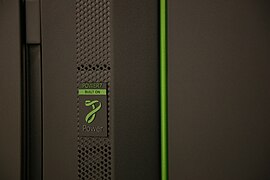
A supercomputer is a type of computer with a high level of performance as compared to a general-purpose computer. The performance of a supercomputer is commonly measured in floating-point operations per second (FLOPS) instead of million instructions per second (MIPS). Since 2017, supercomputers have existed which can perform over 1017 FLOPS (a hundred quadrillion FLOPS, 100 petaFLOPS or 100 PFLOPS). For comparison, a desktop computer has performance in the range of hundreds of gigaFLOPS (1011) to tens of teraFLOPS (1013). Since November 2017, all of the world's fastest 500 supercomputers run on Linux-based operating systems. Additional research is being conducted in the United States, the European Union, Taiwan, Japan, and China to build faster, more powerful and technologically superior exascale supercomputers.
Floating point operations per second is a measure of computer performance in computing, useful in fields of scientific computations that require floating-point calculations.

Blue Gene was an IBM project aimed at designing supercomputers that can reach operating speeds in the petaFLOPS (PFLOPS) range, with low power consumption.
Cray Inc., a subsidiary of Hewlett Packard Enterprise, is an American supercomputer manufacturer headquartered in Seattle, Washington. It also manufactures systems for data storage and analytics. Several Cray supercomputer systems are listed in the TOP500, which ranks the most powerful supercomputers in the world.

MareNostrum is the main supercomputer in the Barcelona Supercomputing Center. It is the most powerful supercomputer in Spain, one of thirteen supercomputers in the Spanish Supercomputing Network and one of the seven supercomputers of the European infrastructure PRACE.

POWER7 is a family of superscalar multi-core microprocessors based on the Power ISA 2.06 instruction set architecture released in 2010 that succeeded the POWER6 and POWER6+. POWER7 was developed by IBM at several sites including IBM's Rochester, MN; Austin, TX; Essex Junction, VT; T. J. Watson Research Center, NY; Bromont, QC and IBM Deutschland Research & Development GmbH, Böblingen, Germany laboratories. IBM announced servers based on POWER7 on 8 February 2010.

The TOP500 project ranks and details the 500 most powerful non-distributed computer systems in the world. The project was started in 1993 and publishes an updated list of the supercomputers twice a year. The first of these updates always coincides with the International Supercomputing Conference in June, and the second is presented at the ACM/IEEE Supercomputing Conference in November. The project aims to provide a reliable basis for tracking and detecting trends in high-performance computing and bases rankings on HPL benchmarks, a portable implementation of the high-performance LINPACK benchmark written in Fortran for distributed-memory computers.
High Productivity Computing Systems (HPCS) is a DARPA project for developing a new generation of economically viable high productivity computing systems for national security and industry in the 2002–10 timeframe.
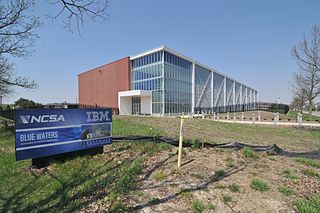
Blue Waters was a petascale supercomputer operated by the National Center for Supercomputing Applications (NCSA) at the University of Illinois at Urbana-Champaign. On August 8, 2007, the National Science Board approved a resolution which authorized the National Science Foundation to fund "the acquisition and deployment of the world's most powerful leadership-class supercomputer." The NSF awarded $208 million for the Blue Waters project.

JUGENE was a supercomputer built by IBM for Forschungszentrum Jülich in Germany. It was based on the Blue Gene/P and succeeded the JUBL based on an earlier design. It was at the introduction the second fastest computer in the world, and the month before its decommissioning in July 2012 it was still at the 25th position in the TOP500 list. The computer was owned by the "Jülich Supercomputing Centre" (JSC) and the Gauss Centre for Supercomputing.
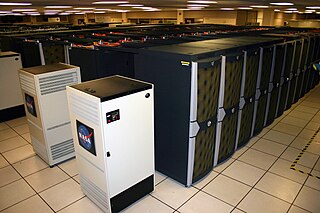
Pleiades is a petascale supercomputer housed at the NASA Advanced Supercomputing (NAS) facility at NASA's Ames Research Center located at Moffett Field near Mountain View, California. It is maintained by NASA and partners Hewlett Packard Enterprise and Intel.
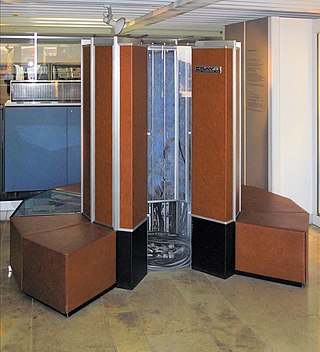
The history of supercomputing goes back to the 1960s when a series of computers at Control Data Corporation (CDC) were designed by Seymour Cray to use innovative designs and parallelism to achieve superior computational peak performance. The CDC 6600, released in 1964, is generally considered the first supercomputer. However, some earlier computers were considered supercomputers for their day such as the 1954 IBM NORC in the 1950s, and in the early 1960s, the UNIVAC LARC (1960), the IBM 7030 Stretch (1962), and the Manchester Atlas (1962), all of which were of comparable power.

Several centers for supercomputing exist across Europe, and distributed access to them is coordinated by European initiatives to facilitate high-performance computing. One such initiative, the HPC Europa project, fits within the Distributed European Infrastructure for Supercomputing Applications (DEISA), which was formed in 2002 as a consortium of eleven supercomputing centers from seven European countries. Operating within the CORDIS framework, HPC Europa aims to provide access to supercomputers across Europe.

Yellowstone was the inaugural supercomputer at the NCAR-Wyoming Supercomputing Center (NWSC) in Cheyenne, Wyoming. It was installed, tested, and readied for production in the summer of 2012. The Yellowstone supercomputing cluster was decommissioned on December 31, 2017, being replaced by its successor Cheyenne.

Approaches to supercomputer architecture have taken dramatic turns since the earliest systems were introduced in the 1960s. Early supercomputer architectures pioneered by Seymour Cray relied on compact innovative designs and local parallelism to achieve superior computational peak performance. However, in time the demand for increased computational power ushered in the age of massively parallel systems.
The PRIMEHPC FX10 is a supercomputer designed and manufactured by Fujitsu. Announced on 7 November 2011 at the Supercomputing Conference, the PRIMEHPC FX10 is an improved and commercialized version of the K computer, which was the first supercomputer to obtain more than 10 PFLOPS on the LINPACK benchmark. In its largest configuration, the PRIMEHPC FX10 has a peak performance 23.2 PFLOPS, power consumption of 22.4 MW, and a list price of US$655.4 million. It was succeeded by the PRIMEHPC FX100 with SPARC64 XIfx processors in 2015.

Appro was a developer of supercomputing supporting High Performance Computing (HPC) markets focused on medium- to large-scale deployments. Appro was based in Milpitas, California with a computing center in Houston, Texas, and a manufacturing and support subsidiary in South Korea and Japan.
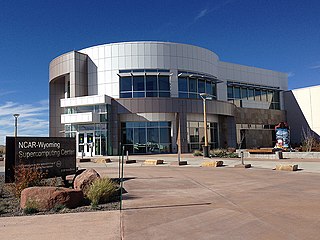
The NCAR-Wyoming Supercomputing Center (NWSC) is a high-performance computing (HPC) and data archival facility located in Cheyenne, Wyoming, that provides advanced computing services to researchers in the Earth system sciences.
The Multiprogram Research Facility is a facility at the Oak Ridge National Laboratory in Oak Ridge, Tennessee. It is used by the U.S. National Security Agency (NSA) to design and build supercomputers for cryptanalysis and other classified projects. It houses the classified component program of the High Productivity Computing Systems (HPCS) project sponsored by the Defense Advanced Research Projects Agency (DARPA).

Sierra or ATS-2 is a supercomputer built for the Lawrence Livermore National Laboratory for use by the National Nuclear Security Administration as the second Advanced Technology System. It is primarily used for predictive applications in nuclear weapon stockpile stewardship, helping to assure the safety, reliability, and effectiveness of the United States' nuclear weapons.
